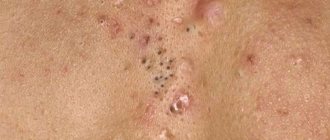The article was checked by a mammologist of the highest category, Ph.D. Zorina E.Yu. , is for general informational purposes only and does not replace specialist advice. For recommendations on diagnosis and treatment, consultation with a doctor is necessary.
At the Yauza Clinical Hospital, highly informative and safe methods are used to assess the condition of the mammary gland and identify the presence and causes of lumps or nodes (digital low-dose mammography, ultrasound, MR mammography, ductography, histological examination of biopsy material, etc.). If pathological formations are detected, the specialist will prescribe complex treatment - effective drug therapy, and, if necessary, surgical intervention.
Does a lump in the chest always indicate a pathological process? Nodules associated with hormonal changes in the body (pregnancy, lactation, menopause, etc.) can disappear on their own when hormonal levels normalize. In other cases, our mammologists, after a thorough diagnosis, will prescribe and carry out treatment.
Make an appointment
Causes of lumps and nodes in the mammary gland
The appearance of lumps in the mammary gland may be associated with an imbalance due to the use of contraceptives, pathological disorders of the thyroid gland, ovarian dysfunction, and mastitis. Injuries, chest bruises, and stress lead to the formation of knots. The consequence may be abortion, menopause, and disorders in the reproductive system. You should not wear a tight bra.
The lump can be the size of a small pea or the size of a grapefruit. Small size is not a reason to ignore the problem. Often small tumors grow to gigantic proportions in a short time. If you notice a lump in your breast, make an appointment with your doctor immediately. It may save your life and certainly keep you healthy.
Inflammatory diseases
More common inflammatory pathologies of the mammary glands include mastitis caused by staphylococci.
Types of mastitis:
- Non-lactational. Has an acute or chronic form. Develops with bruises, hypothermia, burns.
- Lactational. Consequence of lactostasis during breastfeeding.
- Galactophorite. Inflammation of the ducts.
- Purulent. Abscess or phlegmon of the mammary gland, followed by the formation of a compaction.
- Non-purulent. Inflammatory process with serous sweating of tissues.
Mastitis is accompanied by pain, tissue swelling, lump formation, fever, weakness, and signs of intoxication.
Specific infections
Nonspecific breast infections include tuberculosis and syphilis. With tuberculosis, hypertrophy and thickening of the breast, hyperemia of the skin and enlargement of regional lymph nodes are observed.
Syphilis of the mammary glands is rare, has a long course and is characterized by systemic damage to the body. Develops in three stages. The causative agent is a pale spirochete that penetrates through microcracks and has the ability to reproduce rapidly. The disease is contagious at any stage. This type of syphilis is not transmitted to men.
Traumatic injuries
Chest injuries are common among women of all ages. Bruises are accompanied by aching and severe pain. Damage may be open or closed. The traumatic factor leads to damage to blood vessels and bleeding into the tissue, resulting in the formation of hematomas with clear boundaries of blue or maroon color.
If the areola or nipple area is bruised, traumatic shock may occur. Open wounds carry the risk of infection.
Consequences of illnesses, injuries and operations
The seals formed after a bruise are not malignant in nature, but can subsequently degenerate. Breast injuries are especially dangerous if a woman has nodular mastopathy. If you do not consult a doctor in a timely manner, dangerous complications develop.
These include:
- Fat necrosis. Focal death of breast tissue, with the appearance of a painful lump. There is deformation of the breast, retraction of the skin and a change in its color. A benign tumor does not degenerate into a cancerous tumor on its own, but can become a provoking factor.
- Calcifications. Calcification of soft breast tissue. The accumulation of calcium salts in the mammary gland develops against the background of some disease, including cancer (in 20% of cases). On palpation they are detected with an increase of more than 1 cm.
- Capsular contracture. Growth of fibrous tissue around the implant after mammoplasty. Compression of a foreign body leads to breast deformation, the appearance of a seal in the gland area, contouring of the implant, and discomfort.
- Polyacrylamide gel knots. Complicated condition after breast surgery using polyacrylamide gel. The transformation of the gel into capsules in the form of subcutaneous seals and movement to other parts of the body is observed. The development of a massive inflammatory process with purulent discharge is possible.
Bruising of the mammary glands is accompanied by swelling and pain. Sometimes injuries lead to clear or bloody discharge from the nipple. Any breast should be a reason to contact a mammologist for a detailed diagnosis.
Make an appointment
What does pain indicate?
For most women, burning and mutual dull pain in the chest is a consequence of premenstrual syndrome. A burning sensation and pain in the chest is observed at the beginning of pregnancy.
Lumpiness and tenderness in the breasts occurs when milk accumulates in the mammary glands of a nursing mother. When cracks form in the nipples, there is a risk of infection and the development of mastitis.
Localized pain and burning in the chest can be the cause of the development of benign formations. This pain intensifies in a certain position of the body.
Burning and pain in one side of the chest may indicate the development of cancer. Tumor formations of the breast are most often located in the upper outer quadrant.
Types of breast lumps
There are several types of breast tumors. Each of them is characterized by certain symptoms.
Mastopathy
More information about the forms of mastopathy:
- Fibrous. A benign formation that occurs in glandular or connective tissues. Possible degeneration into a malignant tumor.
- Fibrocystic. Benign formations. It manifests itself as changes in the consistency of the mammary gland, cyclical pain, the formation of fibrosis and cysts, due to the reaction of the mammary gland tissue to hormones, estrogens and progesterone.
- Nodal. Benign dysplasia with the presence of pronounced centers of compaction (nodules). It develops due to hormonal imbalance and is characterized by excessive formation of connective tissue in the chest.
- Adenosis. It is a form of fibrocystic mastopathy, in which there is an increase in glandular tissue. Main symptoms: pain, lump formation, nipple discharge, breast engorgement.
Benign breast tumors
- Fibroma. Dense, painless, benign spherical compaction. Before menstruation, there is a feeling of fullness in the chest. Seals can be single or multiple, well demarcated and mobile. The size varies from a few millimeters to several centimeters.
- Adenoma. A benign formation, which may be caused by hormonal imbalance. The tumor grows from epithelial cells and is diagnosed before the age of 40. Usually located closer to the surface of the gland in the form of a movable, elastic spherical seal.
- Fibroadenoma. It is benign in nature and belongs to the form of nodular mastopathy. Develops from glandular tissue. In 5% of cases it poses an oncological threat. More common in women of reproductive age. It manifests itself as pain and discomfort.
- Lipoma. It is a benign, dense formation in the breast structure, originating from adipose tissue. The tumor has a round shape, elastic and mobile.
- Fibrolipoma. The seal consists of fibrous and fatty tissue. It can be felt as a mobile, compacted node. With a long course of the disease, symptoms are completely absent. Increasing in size, it causes deformation of the mammary gland, sometimes calcification. Transformation into cancer is very rare.
- Galactocele. A cyst-like formation filled with milk-like contents. In the initial stages, there is no clinical picture of the disease. Enlargement is accompanied by discomfort and deformation of the breast. Signs of intoxication may be present.
- Intraductal papilloma. Refers to benign formations. It is localized in dilated areas of the mammary gland ducts, under the areola, near the nipple. It is a wart covered with papillae on the ductal wall. It is easily injured and bleeds, resulting in copious yellow-green, brown or milky discharge from the nipple.
Leaf-shaped tumor
The leaf-shaped tumor is fibroepithelial in nature and carries a potential risk of developing a malignant formation. It is distinguished by two phases of development: a long course (sometimes taking several decades) and dynamic development.
The formation is localized in the center of the chest or in the upper part, spreading to the entire mammary gland or most of it. As malignancy develops, the lungs, liver and bone tissue are affected. The lymphatic system does not become inflamed. Characterized by a tendency to relapse.
What are seals?
Typically, lumps are lumps and collections of natural substances in the body (such as fat or lymph). Sometimes they are the initial step in the formation of tumors: both benign and malignant.
If the resulting neoplasm not only provokes pain, but is also accompanied by an increase in body temperature, general malaise, dizziness and other symptoms, then a medical examination should be performed. It is also worth sounding the alarm when, after a few days, the compaction does not go away, but only grows.
Typically, lumps are found in the nose, on the earlobes, and behind the ears. First, you should be examined by an otolaryngologist. After the initial examination, the patient may be referred to a surgeon or oncologist. But usually treatment is carried out by an ENT specialist.
Malignant breast tumors
- Hormone-dependent cancer. A malignant neoplasm that develops from glandular tissue, the cells of which contain specific receptors that are sensitive to progesterone and estrogens. It is characterized by enlargement of regional lymph nodes, discharge from the nipples, diffuse or limited compaction in the chest area, changes in the skin and shape of the mammary glands. Symptoms of tumor intoxication are observed.
- Breast cancer in pregnant women. A malignant tumor detected during pregnancy, breastfeeding or within a year after the birth of a child. Symptoms manifest themselves in the form of diffuse or nodular thickening of the mammary glands, enlargement of the axillary lymph nodes. Patients are concerned about pain, heaviness and discomfort in the chest. Uncharacteristic discharge from the nipple and local changes in the skin are observed.
- Triple negative breast cancer. The most aggressive type of malignant neoplasm, in which the tumor cells lack targets for attack (progesterone, epidermal growth factor, estrogen). A dense, voluminous node is formed, regional lymph nodes enlarge, changes in the skin are observed, the mammary gland is noticeably deformed, and discharge from the nipple appears.
- Hereditary cancer. The development of a tumor is associated with genetic changes that were inherited through a female or male cell from predecessors and are associated with an increased risk of developing the disease.
- Recurrent cancer. A type of cancer that develops after a period of remission when no abnormal cells have been detected in the body. Relapses are more dangerous than the primary tumor. As a serious complication of cancer, they have a more toxic effect on the body.
- Paget's cancer. A form of malignant breast tumors that affects the nipple and areola. A lump is felt in the chest, pain, itching, and burning appear. The nipple becomes deformed and yellow or bloody discharge appears. The peripapillary area is easily injured, bleeds, and becomes covered with a crust. The axillary lymph nodes are enlarged.
- Invasive ductal carcinoma. It is one of the most common types of malignant breast tumors. It begins to develop in the milk ducts of the breast, can break out of the ducts and penetrate into the surrounding tissue. Signs of the disease manifest themselves in the form of swelling and pain in the chest, retraction of the nipples.
Sarcoma of the breast
Sarcoma in its morphology is a tumor of connective tissue origin, and not epithelial. Accounts for approximately 0.2-0.6% of all malignant neoplasias. Can be detected at any age.
In the initial stages of development, most malignant neoplasms do not cause pain. Therefore, even if the compaction does not cause discomfort, you should definitely visit a doctor to determine the nature of the pathology. Make an appointment with a specialist to protect yourself from serious illnesses.
Mastitis
Mastitis is an inflammatory disease of the mammary gland that occurs as a result of infection (Staphylococcus aureus, Streptococcus) mainly through cracks in the nipple when feeding a child. Most often it develops in lactating women in the postpartum period, and may also not be associated with lactation. With mastitis, inflammation of the milk ducts occurs, and milk mixed with pus may be released. The appearance of compaction and nodular formation in one or more lobules of the mammary gland is observed. A mobile, painless compaction with clear boundaries is palpated.
Make an appointment
Breast cysts
A breast cyst is a pathological cavity filled with liquid contents. It manifests itself as aching pain, which is associated with an increase in formation that compresses the surrounding tissues.
Hyperplastic breast lobules
A hyperplastic lobule of the mammary gland is an enlargement of the lobe of the mammary gland. It occurs mainly during pregnancy and can cause the development of fibrocystic mastopathy. No treatment required.
Features of the Lakhta Milon laser
Modern science has long appreciated all the advantages of using lasers in medicine. Therefore, today new, more advanced devices are constantly appearing, one of which is the domestically produced Lakhta Milon device.
With its help, you can perform minimally invasive operations in the shortest possible time, differing in:
- high degree of security,
- efficiency,
- speed,
- short recovery period,
- no need for general anesthesia.
Diagnosis of the causes of lumps and nodes in the mammary gland
- Consultation with a mammologist. The mammologist will examine the patient, palpate, identify a lump or nodule, prescribe all the necessary tests and, if necessary, refer for consultation to other specialists in our center - oncologist, gynecologist, geneticist, endocrinologist, surgeon.
- Instrumental studies : Ultrasound of the mammary glands;
- ductography;
- digital and MR mammography.
- biopsy followed by histological examination;
If the examination revealed one or another pathology, the mammologist will draw up an individual treatment program.
Most breast lumps are not ultimately cancerous. However, to be sure of this, it is necessary to undergo a high-quality examination. By making an appointment now, you will have the opportunity to undergo diagnostics using the latest equipment at a time convenient for you.
Nodes in the veins of the legs: treatment and its features
Treatment of nodes in the veins of the legs begins only after the patient has undergone a series of laboratory and instrumental examinations, the key of which is ultrasound duplex scanning of the vessels of the lower extremities.
Based on the results obtained, the phlebologist can judge the need for minimally invasive surgical intervention and the degree of its safety for the patient. Vein nodules in the leg can be eliminated under local anesthesia in several ways.
- Laser coagulation of a vessel, which involves introducing a special device into the cavity of a blood vessel and “welding” its walls with thermal radiation. Due to this, it stops filling with blood and is completely excluded from the bloodstream.
- Miniphlebectomy, the essence of which is the complete removal of the affected superficial vessels by removing them from the thickness of the tissue through small punctures.
Treatment of compactions and nodes in the mammary glands
Treatment of breast lumps and nodules depends on the cause. The exception is the hyperplastic lobule, which is a variant of the norm and does not require treatment. But observation by a specialist with such a diagnosis is necessary.
In other cases we use:
- conservative therapy;
- surgical treatment: opening of the abscess, sectoral resection of the mammary gland without removing the breast for benign tumors; radical resection (with underlying areas of muscle and fascia) or mastectomy with removal of regional lymph nodes in case of malignant processes, subsequently plastic reconstructive and aesthetic surgeries are possible;
- chemotherapy for malignant neoplasms.
Self-examination is of great importance for the early detection of breast pathology, which should be carried out regularly. If you find lumps in your breasts, consult a specialist. The success of treatment directly depends on the early diagnosis of the disease. Doctors at the Yauza Clinical Hospital will identify the cause and help you cope with any breast disease.
Cost of services
You can see prices for services
Treatment
Pre-hospital assistance
Breast tightening is often a sign of a dangerous disease; in the absence of timely assistance, dangerous complications may develop. Self-medication when this pathology is detected is unacceptable. For severe pain, a single dose of an analgesic is possible. After identifying a lump, you should immediately contact a mammologist.
Conservative therapy
Treatment tactics are determined by the nature of the pathology that caused the formation of a lump in the chest. It is possible to use etiotropic, pathogenetic, symptomatic agents, and physiotherapeutic methods of treatment. The most commonly used drugs are the following groups:
- Antibiotics
. Necessary for mastitis and other infectious diseases of the breast. At the initial stage, broad-spectrum medications are prescribed, then the antibiotic regimen is adjusted taking into account the results of microbiological analysis. - Hormonal drugs
. Antiestrogens are recommended for patients suffering from mastopathy. Medicines minimize the influence of female hormones on the condition of the mammary gland and help prevent the progression of pathological changes. - NSAIDs
. Indicated for patients with mastitis, injuries, and consequences of breast injuries. Reduce the severity of inflammation, reduce swelling and pain. - Cytostatics.
They are part of the treatment of malignant breast tumors. They can be used alone or in combination with radiation therapy, and prescribed in preparation for surgery.
Which doctor should I contact for examination?
You should know that mastopathy and mastitis can cause the development of cancer. Regular examinations by a specialist will help avoid dangerous pathologies. If you have pain or lumps in the mammary glands, you should contact a mammologist. After an accurate diagnosis, he will prescribe appropriate treatment.
Make an appointment
For preventive purposes, it is recommended to visit a mammologist annually. In case of complicated heredity, due to individual characteristics, in the presence of concomitant pathologies, additional visits to the doctor are required.
What symptoms require immediate medical attention?
If the following signs appear, you should consult a specialist:
- Aching pain in the chest and mammary glands.
- Well palpable lumps in the chest.
- Stagnation of breast milk during lactation, changes in its color and smell.
- Formation of weeping wounds on the skin.
- Unpleasant-smelling nipple discharge.
- A sharp change in the size and shape of the mammary glands.
- Itching of the nipples and any change in their appearance.
You should not postpone a visit to the doctor if breast swelling appears after the installation of implants. Patients with chronic sexual diseases must undergo routine examinations. Regular visits to a mammologist are recommended for women with a family history. Trauma to the chest can lead to the formation of cysts or tumors.
Diagnostics
Diagnostic measures are carried out by a mammologist. The specialist finds out from the patient the time and circumstances of the onset of the symptom, and examines the dynamics of the disease. The mammologist assesses the condition of the nipple-alveolar zone, skin, underlying tissues, identifies deformations, determines the location, size, consistency, mobility of the compaction, and examines regional lymph nodes. To clarify the diagnosis, the following are prescribed:
- Sonography.
A safe, basic way to study the mammary glands. Detects tumors, areas of inflammation, structural abnormalities. It is more informative in young women, since their breast tissue is denser and is well visualized during ultrasound. - Mammography.
A type of radiography. Preferred in older women. Confirms fibrous changes, tumor formations. To increase information content, it can be supplemented with ductography. If the results of the procedure are ambiguous, digital tomosynthesis is performed. Patients with cysts undergo pneumocystography. - Breast biopsy.
To obtain a tissue sample, a puncture, fine-needle biopsy, or trephine biopsy are performed under ultrasound or x-ray control. Points and biopsies are sent for microbiological examination to identify the pathogen, cytological or histological analysis to exclude malignancy. - Other visualization techniques
. MRI and scintigraphy are used to clarify the size and localization of malignant neoplasia and to select surgical treatment tactics. Patients with endoprostheses undergo MRI monitoring of breast implants according to indications. - Lab tests
. Prescribed determination of the level of sex hormones, analysis of tumor markers, blood tests to assess the severity of inflammation, microbiological analysis of discharge from the mammary gland.










